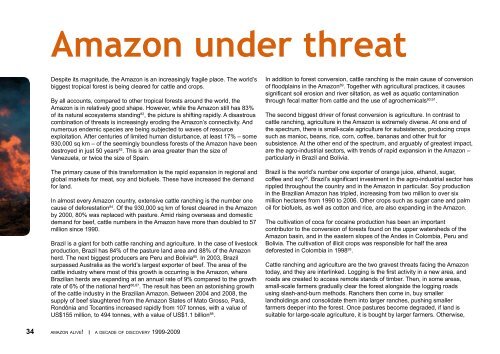Amazon Alive: A Decade of Discoveries 1999-2009 - WWF
Amazon Alive: A Decade of Discoveries 1999-2009 - WWF
Amazon Alive: A Decade of Discoveries 1999-2009 - WWF
You also want an ePaper? Increase the reach of your titles
YUMPU automatically turns print PDFs into web optimized ePapers that Google loves.
<strong>Amazon</strong> under threat<br />
© Nigel Dickinson / <strong>WWF</strong>-Canon<br />
Despite its magnitude, the <strong>Amazon</strong> is an increasingly fragile place. The world’s<br />
biggest tropical forest is being cleared for cattle and crops.<br />
By all accounts, compared to other tropical forests around the world, the<br />
<strong>Amazon</strong> is in relatively good shape. However, while the <strong>Amazon</strong> still has 83%<br />
<strong>of</strong> its natural ecosystems standing 82 , the picture is shifting rapidly. A disastrous<br />
combination <strong>of</strong> threats is increasingly eroding the <strong>Amazon</strong>’s connectivity. And<br />
numerous endemic species are being subjected to waves <strong>of</strong> resource<br />
exploitation. After centuries <strong>of</strong> limited human disturbance, at least 17% – some<br />
930,000 sq km – <strong>of</strong> the seemingly boundless forests <strong>of</strong> the <strong>Amazon</strong> have been<br />
destroyed in just 50 years 83 . This is an area greater than the size <strong>of</strong><br />
Venezuela, or twice the size <strong>of</strong> Spain.<br />
The primary cause <strong>of</strong> this transformation is the rapid expansion in regional and<br />
global markets for meat, soy and bi<strong>of</strong>uels. These have increased the demand<br />
for land.<br />
In almost every <strong>Amazon</strong> country, extensive cattle ranching is the number one<br />
cause <strong>of</strong> deforestation 84 . Of the 930,000 sq km <strong>of</strong> forest cleared in the <strong>Amazon</strong><br />
by 2000, 80% was replaced with pasture. Amid rising overseas and domestic<br />
demand for beef, cattle numbers in the <strong>Amazon</strong> have more than doubled to 57<br />
million since 1990.<br />
Brazil is a giant for both cattle ranching and agriculture. In the case <strong>of</strong> livestock<br />
production, Brazil has 84% <strong>of</strong> the pasture land area and 88% <strong>of</strong> the <strong>Amazon</strong><br />
herd. The next biggest producers are Peru and Bolivia 85 . In 2003, Brazil<br />
surpassed Australia as the world’s largest exporter <strong>of</strong> beef. The area <strong>of</strong> the<br />
cattle industry where most <strong>of</strong> this growth is occurring is the <strong>Amazon</strong>, where<br />
Brazilian herds are expanding at an annual rate <strong>of</strong> 9% compared to the growth<br />
rate <strong>of</strong> 6% <strong>of</strong> the national herd 86,87 . The result has been an astonishing growth<br />
<strong>of</strong> the cattle industry in the Brazilian <strong>Amazon</strong>. Between 2004 and 2008, the<br />
supply <strong>of</strong> beef slaughtered from the <strong>Amazon</strong> States <strong>of</strong> Mato Grosso, Pará,<br />
Rondônia and Tocantins increased rapidly from 107 tonnes, with a value <strong>of</strong><br />
US$155 million, to 494 tonnes, with a value <strong>of</strong> US$1.1 billion 88 .<br />
In addition to forest conversion, cattle ranching is the main cause <strong>of</strong> conversion<br />
<strong>of</strong> floodplains in the <strong>Amazon</strong> 89 . Together with agricultural practices, it causes<br />
significant soil erosion and river siltation, as well as aquatic contamination<br />
through fecal matter from cattle and the use <strong>of</strong> agrochemicals 90,91 .<br />
The second biggest driver <strong>of</strong> forest conversion is agriculture. In contrast to<br />
cattle ranching, agriculture in the <strong>Amazon</strong> is extremely diverse. At one end <strong>of</strong><br />
the spectrum, there is small-scale agriculture for subsistence, producing crops<br />
such as manioc, beans, rice, corn, c<strong>of</strong>fee, bananas and other fruit for<br />
subsistence. At the other end <strong>of</strong> the spectrum, and arguably <strong>of</strong> greatest impact,<br />
are the agro-industrial sectors, with trends <strong>of</strong> rapid expansion in the <strong>Amazon</strong> –<br />
particularly in Brazil and Bolivia.<br />
Brazil is the world’s number one exporter <strong>of</strong> orange juice, ethanol, sugar,<br />
c<strong>of</strong>fee and soy 92 . Brazil’s significant investment in the agro-industrial sector has<br />
rippled throughout the country and in the <strong>Amazon</strong> in particular. Soy production<br />
in the Brazilian <strong>Amazon</strong> has tripled, increasing from two million to over six<br />
million hectares from 1990 to 2006. Other crops such as sugar cane and palm<br />
oil for bi<strong>of</strong>uels, as well as cotton and rice, are also expanding in the <strong>Amazon</strong>.<br />
The cultivation <strong>of</strong> coca for cocaine production has been an important<br />
contributor to the conversion <strong>of</strong> forests found on the upper watersheds <strong>of</strong> the<br />
<strong>Amazon</strong> basin, and in the eastern slopes <strong>of</strong> the Andes in Colombia, Peru and<br />
Bolivia. The cultivation <strong>of</strong> illicit crops was responsible for half the area<br />
deforested in Colombia in 1998 93 .<br />
Cattle ranching and agriculture are the two gravest threats facing the <strong>Amazon</strong><br />
today, and they are interlinked. Logging is the first activity in a new area, and<br />
roads are created to access remote stands <strong>of</strong> timber. Then, in some areas,<br />
small-scale farmers gradually clear the forest alongside the logging roads<br />
using slash-and-burn methods. Ranchers then come in, buy smaller<br />
landholdings and consolidate them into larger ranches, pushing smaller<br />
farmers deeper into the forest. Once pastures become degraded, if land is<br />
suitable for large-scale agriculture, it is bought by larger farmers. Otherwise,<br />
34 amazon alive! I a decade <strong>of</strong> discovery <strong>1999</strong>-<strong>2009</strong>

















